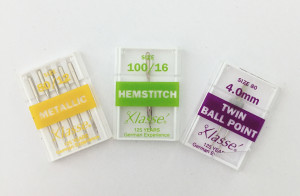
You can’t sew without a needle, but what kind of needle should you use in your sewing machine? Generally speaking, most needles fit most machines, but you need to customize the size and type of needle to the project you’re sewing.
Size
Needles come in different sizes for different fabric weights. The lower the number, the smaller the needle, and the thinner the fabric it’s meant for. Needle size is given as two numbers, such as 70/10. The first number is the European size, the second is American.
|
Size |
Fabric Type |
|
65/9 |
Sheer—chiffon, organza |
|
70/10 |
Very Lightweight—voile, batiste, lawn, tissue knit |
|
75/11 |
Lightweight—quilting cotton, broadcloth |
|
80/12 |
Lightweight—quilting cotton, knit jersey |
|
90/14 |
Medium—thicker broadcloth, chambray |
|
100/16 |
Heavy—denim, twill |
|
110/18 |
Very Heavy—canvas, upholstery |
Needle Type
There are different types of needles for different purposes. Using the wrong needle may cause skipped stitches and/or damaged fabric.
-
Universal needles are for normal woven fabric.
-
Ballpoint needles are for knit jersey and sweater knits. They have a slightly rounded tip that will slip between the threads without snagging.
-
Stretch needles are for woven fabrics that stretch.
-
Jean/Denim needles are for dense, heavy fabrics, like twill.
-
Microtex Sharp needles are extra sharp, for tightly woven fabrics or multiple layers.
-
Leather needles are for leather. They have a special tip designed to slice through leather, making it easier to sew.
-
Metallic needles are specifically for use with metallic thread.
-
Topstitching needles are for when you need a decorative topstitch, like when making jeans.
-
Double or Twin needles are for sewing two rows at the same time. You might do this when topstitching or when hemming knit jersey. They come in universal or ballpoint.
-
Hemstitch or Wing needles are flared, so they produce a small hole with every stitch. Most often used with heirloom sewing.
-
There are other specialty types, too, for embroidery, quilting, etc.

Tips
-
Always keep a varied supply of needles on hand. You never know when you might need to replace one.
-
Most projects tend to have different requirements, so use a fresh needle every time you start a new project.
-
If your fabric is especially heavy or hard to sew through, your needle may go dull sooner than usual and need to be replaced partway through.
-
If your project involves multiple types or weights of fabric, don’t try to use the same needle for all of them. Switch between needles as often as necessary.
-
Sewing machine needles are usually labeled with their size. It’s engraved on the top section, in the smallest lettering you’ve ever seen. Hold it close to a light and rotate the needle slightly to get the right angle to read the numbers. (It’s a bit like reading an old-fashioned thermometer!)
-
When you insert a fresh needle into your sewing machine, the flat side faces away from you.
-
If you hear a clicking or popping sound while sewing, replace the needle. It may have gone dull, it may be the wrong size for the fabric you’re working with, or it may have bent slightly.
-
If you need to switch between several different needles during a project, stick the ones you’re not using at the moment into a piece of paper, with each one clearly labeled. That way, they won’t get mixed up.
-
When you stop sewing for the day, write the size and type of needle you’re using on a sticky note and place it near your sewing machine, so when you come back, you don’t have to guess which needle you left in the machine.
-
Keep your needles in their original packs and organize according to type: universal, ballpoint, etc.
-
If your needle wasn’t used much, return it to the pack backwards, with the flat size facing out. That way, you know which needles are brand-new and which are slightly used.
-
When you need to discard a needle, don’t put it directly in the trash! Use an old prescription pill bottle with a safety cap to hold your used needles and pins. When it’s full, throw it away. (See: Broken Needles)
~~*~~
Learning how to sew? Check out Sewing Basics.
